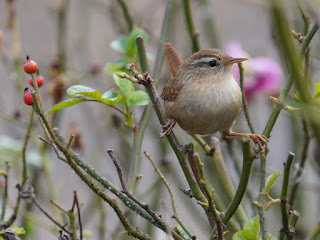A Wren perched on an accidentally seeded rose bush beside the Long Water, now in unseasonal bloom.
A Long-Tailed Tit searched for insects in a gorse bush near the bridge.
A Rose-Ringed Parakeet was chewing rotten wood off a dead tree. I've never seen this behaviour before.
Starlings and Magpies went through a bin at the Lido restaurant. The larger birds can pull things out, making a mess that the restaurant staff have to clear up.
Two Carrion Crows were oddly harmonious in digging something up near the Dell. They must be a couple.
Two Grey Heron nests on the island were occupied. This is the smaller one, which will need building up if it's to be used.
A Black-Headed Gull had found a mysterious object in the Serpentine which it seemed to think was edible. It seemed too large for a hoverfly larva, and lacked the trailing siphon that these larvae have.
But this was certainly a hoverfly larva.
There are a lot of crayfish in the lake, quite close to the edge, and they don't seem to be very active. We may be seeing one of the mysterious mass die-offs that seems to affect these Turkish Crayfish, and which have apparently also completely eliminated the Signal Crayfish we used to have. Both are invasive species, and there aren't any native crayfish here.
The Herring Gulls are catching them enthusiastically.
But the crayfish have to be taken ashore to dismantle them, and that causes a problem with harassment from hungry crows. Here a crow finally succeeded in grabbing the gull's meal.
A young Herring Gull dredged up bits of paper and cardboard, a stone and a stick. None of them seemed to satisfy it as a thing to play with, so it dropped them all.
The Goldeneye is still at the east end of the Serpentine. Since it was first seen on 27 November its adult black and white pattern has developed slightly.
There is a single female Pochard on the Long Water, and I also saw two drakes. Someone else has reported four in all, but that's a long way below the sixty-odd we had a couple of months ago.
There was no sign of a White-Fronted Goose either in the Diana fountain enclosure or at the Round Pond.
On the Round Pond, the Black Swan was again following a male Mute Swan around.












One of those starlings is very possessive about its rubbish bin!
ReplyDeleteStarlings challenge each other for food even more than gulls.
DeleteDo female mute swans usually follow their crushes around?
ReplyDeleteThe Long-Tailed Tit is so rosy and so pretty. I love the colouring of the British sub-species.
Did the crow and the jay forgive you for not producing enough peanuts the other day?
Pairs of Mute Swans often go around together, but not in that clingy way. I think the Black Swan is very lonely. As I have said before, it was very young when it arrived and doesn't seem to know its way around London or that there are Black Swabs in St James's Park five minutes' flight away.
DeleteYes, I have been forgiven for running out of peanuts. I ran out again today, but only after everyone had been fed, and they have to learn that the supply is not inexhaustible.
Nice shot of the Goldeneye again. The Whitefront was around yesterday near the Round Pond at some point as a photo of it was put on the North & West London Birders Whatapp board. Also been reported today in Hyde Park.
ReplyDeleteThe Whitefront was in the Diana enclosure today but I couldn't find the Goldeneye. Hope that was just me being incompetent.
DeleteIs there a South-West Whatsapp group too, by any chance?🙂
DeleteDon't know, sorry. You could ask local birders, but adding someone to a WhatsApp group has to be a decision by its members.
DeleteThese wrens are so annoying 😅 every time I happen to stumble upon one, I always only get to have a shot of their backside 😅 I saw one yesterday, around the chaffinch place at the SW corner of the bridge, but as usual, I only caught it from the back and then disappeared in the bush.
ReplyDeleteThey are very shy and hate being stared at. I'd be a bit careful too if I only weighed 10 grams.
Delete🤣 Too right.
DeleteAre carrion crows usually single?
ReplyDeleteNo. It's hard to spot pairs in a mob, and some younger crows may be unmated, but they seems to have mates for the long term, maybe for life.
Delete